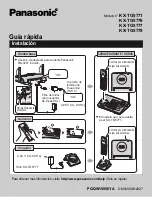
Guideline for safety and efficiency
Cordless telephone OfficeT
2006-05-24/ Ver. B
4
TD 92282GB
Do not transport or store flammable gas, liquid, or explosives in any
compartment of a vehicle which also contains the telephone and
accessories.
In the U.S., vehicles powered by lique.ed petroleum gas (such as
propane or butane) must comply with the National Fire Protection
Standard (NFPA-58). For a copy of this standard, contact the
National Fire Protection Association, One Battery march Park,
Quince, Massachusetts 02269, Attention: Publication Sales
Division.
Operation procedures
In the U.S, cordless telephones are subject to the rules and
regulations of the FCC. Following these rules will help to eliminate
confusion, ensure the most efficient use of the existing frequencies,
and result in a smoothly functioning radio network.
The following offenses are punishable by fine, imprisonment, or
both:
•
Use of profane, indecent, or obscene language.
•
Transmission of a false distress signaler call.
•
Willful or malicious interference with any other radio
communications.
•
Refusal to yield a channel or radio frequency when informed that
it is needed for an emergency call. Emergency calls have priority
over all messages.
•
Adjustment of the equipment by anyone other than a qualified
licensed technician.
Exposure to radio frequency signals
The OfficeT Cordless telephone is a radio transmitter and receiver.
It is designed and manufactured not to exceed the emission limit
for exposure to radio frequency (RF) energy set by the Federal
Communications Commission (FCC) of the U.S. Government and
Canada. These limits are part of comprehensive guidelines and
established permitted levels of RF energy for the general
population. These guidelines are based on the safety standards
previously set by both U.S. and international standards bodies.
These standards include a substantial safety margin designed to
assure the safety of all persons, regardless of age and health. The
exposure standards for wireless mobile telephones employs a unit
of measure known as the Specific Absorption Rate, or SAR.







































